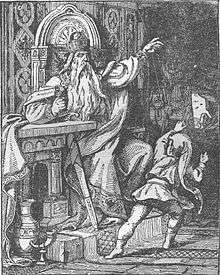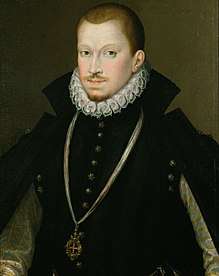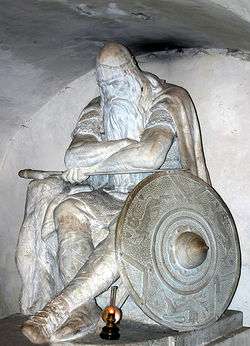King asleep in mountain
The king asleep in mountain (D 1960.2 in Stith Thompson's motif index system)[1] is a prominent folklore motif found in many folktales and legends. Thompson also termed it as the Kyffhäuser type.[2] Some other designations are: king in the mountain, king under the mountain, or sleeping hero.
Examples include the legends of Frederick Barbarossa at Kyffhäuser, Kraljević Marko, Ogier the Dane, King Arthur, Charlemagne, Sebastian of Portugal, and King Matjaž.[3][4]
The motifs A 571 "Cultural hero asleep in mountain", and E 502, "The Sleeping Army" are similar and can occur in the same tale.[1] A related motif is the "Seven Sleepers" (D 1960.1,[2] also known as the "Rip Van Winkle" motif), whose type tale is the Seven Sleepers of Ephesus (AT tale type 766).
General features

King in the mountain stories involve legendary heroes, often accompanied by armed retainers, sleeping in remote dwellings including caves on high mountaintops, remote islands, or supernatural worlds. The hero is frequently a historical figure of some military consequence in the history of the nation where the mountain is located.
The stories gathered by the Brothers Grimm concerning Frederick Barbarossa and Charlemagne are typical of the stories told, and have been influential on many variants and subsequent adaptations. The presence of the hero is unsuspected; until some herdsman wanders into the cave, typically looking for a lost animal, and sees the hero. The stories almost always mention the detail that the hero has grown a long beard, indicative of the long time he has slept beneath the mountain.
In the Brothers Grimm version, the hero speaks with the herdsman. Their conversation typically involves the hero asking, "Do the eagles (or ravens) still circle the mountaintop?" The herdsman, or a mysterious voice, replies, "Yes, they still circle the mountaintop." "Then begone! My time has not yet come."
The herdsman in this story was then supernaturally harmed by the experience: he ages rapidly, he emerges with his hair turned white, and often he dies after repeating the tale. The story goes on to say that the king sleeps in the mountain, awaiting a summons to arise with his knights and defend the nation in a time of deadly peril. The omen that presages his rising will be the extinction of the birds that trigger his awakening.[5][6]
Europe
A number of European kings, rulers, fictional characters and religious figures have become attached to this story. Major examples are King Arthur of Britain and Holy Emperor Frederick Barbarossa, [7][8] Ogier the Dane and William Tell.[8]
Other examples from European regions are as follows:
Baltic states
- A popular motif in Latvian legends involves a castle sinking into ground leaving a hill behind it. Years later somebody finds a way into the hill and somehow guesses the name of the castle causing it to rise again and its ruler and his people to return to the living.
- Vytautas the Great (Lithuania). It is believed he will rise from his grave when the worst danger threatens Lithuania in order to defend the motherland at the last battle.
Britain and Ireland
- King Arthur (Great Britain and Brittany), perhaps the most famous of the "king under the mountain" examples. According to the legend, Arthur was taken away to Avalon to sleep until he was needed by the people of Britain. Several legends talk of a herdsman who stumbles across a cave on mainland Britain, wherein he finds Arthur sleeping, often with his knights and Excalibur by his side. In a variation on this, sometimes the exploring herdsman finds instead just Arthur's knights, or Sir Lancelot, Guinevere and the knights sleeping in wait on the return of the "Once and Future King".
- Merlin of the Arthurian legend, who is imprisoned in an oak tree by Nimue.
- Thomas the Rhymer is found under a hill with a retinue of knights in a tale from Anglo-Scottish border. Likewise, Harry Hotspur was said to have been hunting in the Cheviots when he and his hounds got holed-up in the Hen Hole (or "Hell-hole") awaiting the sound of a hunting horn to awaken them from their slumber. Another border variant concerns a party of huntsmen who chase a roebuck into the Cheviots when they heard the sweetest music playing from the Henhole, however when they entered they became lost and are trapped to this day.[9]
Wales
- Bran the Blessed
- Owain Lawgoch, Welsh soldier and nobleman (14th century)
- Owain Glyndŵr, the last native born Welshman to hold the title "Prince of Wales"; he disappeared after a long but ultimately unsuccessful rebellion against the English. He was never captured or betrayed and refused all Royal pardons.
- An unnamed giant is supposed to sleep in Plynlimon.
Ireland
- Fionn mac Cumhaill is said to sleep in a cave/mountain surrounded by the Fianna (he is differentiated from them because of his large stature). It is told that the day will come when the Dord Fiann is sounded three times and Fionn and the Fianna will rise up again, as strong and well as they ever were. In other accounts he will return to glory as a great hero of Ireland.[10]
- Gearóid Iarla, Earl of Desmond, who dozes under Lough Gur with his silver-shod horse[3]
- Gerald FitzGerald, 8th Earl of Kildare, who is at temporary rest under the Curragh of Kildare[3]
- Dónall na nGeimhlach Ó Donnchú, in legend around Co. Kerry.[11]
England
- King Harold. In Anglo-Saxon legends he survived the Battle of Hastings and will come one day to liberate the English from the Norman yoke[12]
- Sir Francis Drake. It is stated that if England is in deadly peril and Drake's Drum is beaten, then Sir Francis Drake will arise to defend England from the sea. According to the legend, Drake's Drum can be heard at times when England is at war or significant national events take place.
Caucasus region
Armenia
- Mher[13] (see Daredevils of Sassoun)
Georgia
- According to legend, Queen Tamar is not dead, but is instead sleeping in a gold wreathed coffin in a mountain. Allegedly, there will come a day when she will wake, and restore Georgia to its medieval glory.[14]
German-speaking realm
- Charlemagne, Emperor of future Germany, France, and the Low Countries, rests in the Untersberg near Salzburg. (Austria)
- Frederick Barbarossa, Holy Roman Emperor, sleeps in the Kyffhäuser mountain and will rise to save the Empire. (Germany)
- Frederick II, Holy Roman Emperor
- Henry the Fowler, King. (Germany)
Switzerland
- William Tell (Switzerland, in some legends accompanied by two other Tells[8])
Greek, Hellenistic and Byzantine
Ancient Greece
- Theseus (Athens)
- Typhon and Enceladus in Mount Etna
Byzantine Empire
- Constantine I, said to have been turned into a stone statue, although not resting within a mountain.
- Constantine XI Palaiologos, the last emperor of the Eastern Roman Empire, said to have been turned into marble and thus was known as "Marmaromenos", "the Marble King". He was said to be hidden somewhere underground until his glorious return as the Immortal Emperor.
- John III Doukas Vatatzes (also known as "Kaloyannis III'")
Hungarians
- Csaba, the son of Attila the Hun who is supposed to ride down the Milky Way when the Székelys are threatened.
- King St. Stephen, King St. Ladislaus, King Matthias Corvinus
Iberia
- Boabdil, last Islamic prince of Granada. (Spain)[15]
- King Pelayo, Visigothic king of Asturia, credited with beginning the Reconquista. (Spain)
- King Rodrigo (Spain). Said to escape from the Moorish invasion and await for "the time of maximum need" to save his people.

- Sebastian I (Portugal). Said by Sebastianists to one day return during a hazy morning in time of need.
Romania
- Vlad III the Impaler
Scandinavia

- Ogier the Dane (Danish: Holger Danske, Denmark)
- King Olaf I (Norway)
- Väinämöinen, the protagonist of the Finnish national epic Kalevala. At the end of Kalevala, he leaves on a boat, promising to return when he is most needed.
- Knights of Ålleberg (Sweden)
Slavic nations
East Slavic
- Alexander Suvorov (Russia), Russian generalissimo, sleeps in a deep cave where prayer is heard and icon lamp burns. The legend says Suvorov will come back to save his country from a mortal danger.[16]
- Taras Shevchenko, Ukrainian poet and painter (Ukraine), believed to be a supernatural hero (charakternik), is said to sleep under his grave mound in Kanev or even in the Kiev Pechersk Lavra.
South Slavic
- Marko Kraljević (Serbia)
- Matija Gubec (Croatia)
- Kralj Matjaž (Slovenia)
- Napoleon Bonaparte was believed to be still alive and hiding in Irkutsk, Russia, gathering an army to return and conquer the world. According to a Romanian bishop Melchisedech, there was a Slavonic sect whose members shared this belief along with a widespread worship of Napoleon.[17]
West Slavic
- Giewont, a mountain massif which is said to be a sleeping knight (Poland)
- St. Wenceslas (Václav) of Bohemia (Czech Republic). He sleeps in the Blaník mountain (with a huge army of Czech knights) and will emerge to protect his country at its worst time, riding on his white horse and wielding the legendary hero Bruncvík's sword.[18]
Examples in Asia
Asia minor and Middle East
Persia
- Kay Ḵosrow, legendary shah of Persia, many of the companions of the Saošyant are depicted as immortal and asleep, Kay Ḵosrow then revives each of them one by one to assist the Saošyant in his renovative work
East Asia
Mongolia
- A traditional tale of the death of Genghis Khan says he died falling from his horse while being injured, but that whether he died or not is unknown, and he may be merely resting. Every spring and autumn "those who know the secret" of where Genghis is buried are said to put new sets of clothes into his casket and take the old ones out, worn and frayed. Folklore reports another instance of evidence that Genghis would return: every year there is a sacrifice for Genghis Khan in the Ordos and two white horses (the horses of Genghis Khan) appear. In the third year of the Chinese Republic (1914), though, just one horse appeared. When the second horse came, four years later, it had saddle galls. This was taken as evidence that Genghis Khan had been using the horse, and was making ready to appear again.[19]
Japan
- Kūkai, founder of Shingon Buddhism. He is said to be in deep meditation in a temple on Mount Kōya, Wakayama Prefecture, awaiting the coming of Maitreya, the next Buddha.
Philippines
- Bernardo Carpio, the "King of the Tagalogs", is said to be trapped in the mountains of Rodriguez, Rizal, east of Metro Manila on Luzon. Legend has it that Carpio, a man of superhuman strength, causes earthquakes as he struggles to break free of his chains.
Tibet
- Gesar of Ling, believed by the Tibetans to return one day and restore order on Earth
Examples from the Americas
United States
- The Pueblo hero-god Montezuma — believed to have been a divine king in prehistoric times, and suspended in an Arizona mountain that bears his image.
- The Sleeping Ute mountain in Colorado is said to have been a "Great Warrior God" who fell asleep while recovering from wounds received in a great battle with "the Evil Ones" (there are many other variants of this legend)
- Tecumseh of the Shawnee
- Emperor Norton is claimed by several defunct civil rights groups to have been destined to return to the USA when the unity of the Republic is at its nadir.
Peru
- The Inkarri (from Spanish Inca Rey, "Inca King") of the indigenous peoples of Peru, who will return one day to restore the Inca Empire.[20] There are two main versions of the myth with several local variations:
- In the first, Inkarri was the last Sapa Inca. He was decapitated by the Spaniards, who buried his head in an unknown location. The head is not dead but hibernating while it regenerates the rest of the body. When the regeneration is complete, Inkarri will return.
- In the second, Inkarri and his wife Qollari were the founders of Cusco. They fled to the Amazon jungle (to a place called Paititi, or variations thereof), where they sleep under rocks and will return one day.
Examples by religion
Judaism
- Golem of Prague, whose remains are said to be in the attic of the Old New Synagogue in Prague, and that it can be brought back to defend the Jewish people, in Jewish mystic lore among the Ashkenazim.
- King David is depicted in Hayim Nahman Bialik's tale "King David in the Cave" as sleeping along with his warriors deep inside a cave, waiting for the blast of the ram's horn that will awaken them from their millennia of slumber and arouse them to redeem Israel.[21][22] This role was not attributed to King David in earlier Jewish tradition.
Christianity
- St. John the Evangelist – according to the Golden Legend, he is only sleeping in his grave at Ephesus until the coming of the Antichrist, when he would be needed as a witness.[23][24]
Islam
- Muḥammad al-Mahdī (Shīʿa motif, identified with the mysterious son of Ḥasan al-ʿAskarī, but occasionally other important figures in Shīʿa history (e.g. al-Ṭayyib Abū al-Qāṣim), sometimes called the Qāʾim, when identified with a historical figure as opposed to someone yet-to-come, the individual is endowed with unnaturally long lifespan and is said to be in occultation)
- al-Ḥākim bi-Amr Allāh (either died or disappeared in 1021 AD at the age of 35, is believed by the Druzes to return at the End of Time to rule from Egypt)
Hinduism
- Kṛṣṇa, informs Arjuna during the Bhagavad Gītā that he periodically returns to Earth to establish order and justice, the Mahābhārata then claims that Viṣṇu will appear as Kalki at the end of the Kali Yuga to rule as king, Viṣṇu is often depicted as asleep, but is woken up by entreaties for help by the other gods
Sleeping anti-hero and villain
Sometimes this type of story or archetype is also attached to not-so-heroic figures, who are either simple anti-heroes or fully villains, whose return would mean the end of the world, or whose sleep represents something positive. This kind of archetype is known as the "Chained Satan" archetype.[25] Among examples of this are:
- The Sleeping Giant mountain in Connecticut, United States was said by the local Quinnipiac Indians to be the demon Hobbomock, sealed by the Great Spirit. One day he would supposedly awaken and destroy the world.
- Artavasdes I of Armenia, who according to Moses of Chorene was chained and cursed to stay eternally chained by his father Artaxias I.[25]
- Loki in Norse mythology was bound by the gods after he engineered the death of Baldr. With the onset of Ragnarök, Loki is foretold to be set free and fight alongside the forces of the jötnar against the gods.
- Dukljan (Serbian mythology)
See also
References
- Ó hÓgáin (1991), p. 197.
- Thompson, Stith (1977), The Folktale, University of California Press, pp. 264–265
- Ó hÓgáin (2000), p. 92.
- Henken, Elissa R. (1996), National Redeemer: Owain Glyndŵr in Welsh Tradition, Cornell University Press, p. 83
- Jacob and Wilhelm Grimm, Deutsche Sagen (1816/1818), no. 23.
- Kaiser Karl im Untersberg (German)
- Ó hÓgáin (1992–1993), pp. 58-59.
- Ashliman, D. L. (1999–2020). "Sleeping Hero Legends". Pitt.edu. Retrieved 8 May 2018.
- Henry Tegner; Ghosts of The North Country, 1991 Butler Publishing, ISBN 0-946928-40-1. p.13
- Augusta, Lady Gregory – Gods and Fighting Men (1904)
- Ó hÓgáin (1992–1993), p. 59.
- The Science of Fairy Tales: An Enquiry Into Fairy Mythology, Edwin Sidney Hartland, 1925 edition, p. 143
- Mher in the Carved Rock, J. A. Boyle, at the Library of the University of Canterbury, Christchurch, New Zealand
- Queen Tamar: Her Significance, Sargis Kakabadze
- Ellen M. Dolan, Sue D. Royals, Building Comprehension - Grade 5, p. 29. Milliken Publishing, 1999, ISBN 978-0787703943
- "Елена Лебедева. Русский архистратиг / Православие.Ru".
- The Science of Fairy Tales: An Enquiry Into Fairy Mythology, Edwin Sidney Hartland, 1925 edition, p. 144
- Alois Jirásek, Old Bohemian Legends (1894, Staré pověsti české)
- Owen Lattimore, Mongol Journeys, London: Doran & Co., 1941, pp. 35–37
- OMER, Aurélie. Cuatro versiones inéditas del mito de Inkarrí. Áreas de estudio: Shipetiari y Quero. Revista de Crítica Literaria Latinoamericana, 2015, vol. 41, no 81, p. 405-434.
- "Canaanism:" Solutions and Problems Archived 2012-07-17 at Archive.today, Boas Evron, Alabaster's Archive
- "הַמֶּלֶךְ דָּוִד בַּמְּעָרָה / ח"נ ביאליק". www.benyehuda.org.
- Isidore of Seville – De ortu et obitu patrum (5th century)
- Jacobus de Voragine – The Golden Legend
- "School of Humanities and Creative Arts - University of Canterbury" (PDF). The University of Canterbury. Retrieved 8 May 2018.
Bibliography
- Ó hÓgáin, Dáithí (1991), "Has the Time Come?' (MLSIT 8009): The Barbarossa Legend in Ireland and Its Historical Background", Béaloideas, 59: 197–207 JSTOR 20522387
- —— (1992–1993), pp. 57–74, JSTOR 20522397 https://books.google.com/books?id=-_8hAQAAMAAJ&q=D%C3%B3nall Missing or empty
|title=(help) - —— (2000), "The Importance of Folklore within the European Heritage: Some Remarks", Béaloideas, 68: 67–98, JSTOR 20522558